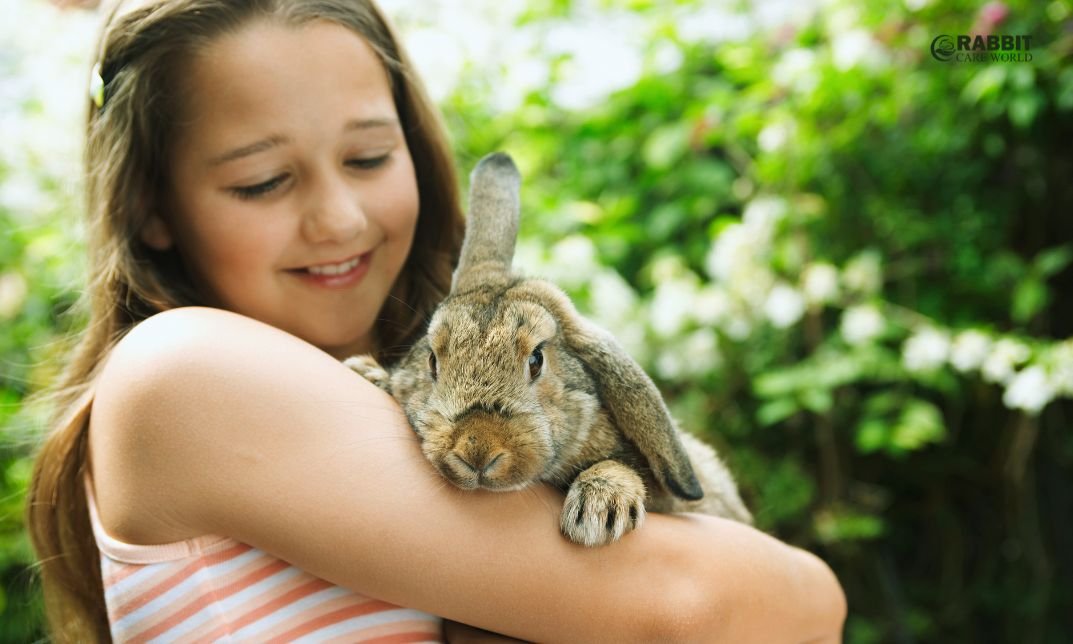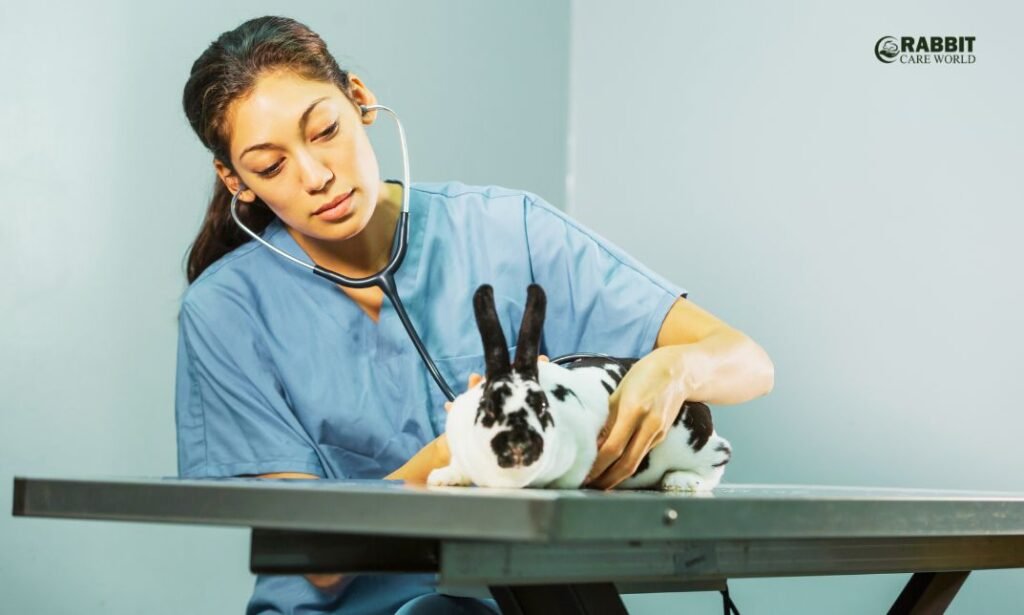Table of Contents
ToggleHow to Train a Rabbit for Therapy Work Overview
Discover how to train a rabbit for therapy work through kindness and trust. Learn step-by-step training tips, socialisation, health care, and how to prepare your bunny for UK therapy visits. Perfect for gentle owners who want to share love and calm with others.
Why Choose a Rabbit for Therapy Work?
Rabbits are gentle, quiet, and irresistibly soft. They’re perfect for people who feel anxious around louder animals like dogs. Rabbits also fit easily into smaller spaces, making them ideal for visits to care homes, schools, or hospitals.
Their calm presence lowers stress and blood pressure, encourages social interaction, and brings comfort to people recovering from illness or loneliness. When trained well, a therapy rabbit can touch countless lives.
If you’ve ever wondered how to train a rabbit for therapy work, you’re in the right place. Rabbits can bring real comfort and joy to people in need. With patience, love, and gentle training, your bunny can become a calm, caring therapy companion. This guide explains each step in a simple way, helping you and your rabbit make a positive difference together.

Why Rabbits Make Wonderful Therapy Animals
Rabbits are naturally calm and sensitive. They don’t bark, jump, or overwhelm people. Their size and softness help anxious or lonely people relax.
In the UK, therapy programmes are growing fast. Rabbits are now part of emotional support visits in hospitals and nursing homes. People who may not talk much often open up when holding a gentle bunny.
Step 1: Understanding Rabbit Temperament for Therapy
Before any training begins, it’s important to check your bunny’s personality. Not every rabbit enjoys being around strangers, and that’s fine.
A good rabbit temperament for therapy looks like this:
- Calm and curious but not jumpy
- Comfortable with gentle handling
- Friendly around people and other pets
- Not easily scared by new places or sounds
Step 2: Build a Bond First
Before training begins, your rabbit must trust you completely. Building a bond helps your bunny feel safe, calm, and ready to learn. Spend time together daily so your rabbit sees you as a friend, not a threat. This emotional connection makes every next step smoother and happier.
A strong rabbit–owner bond for therapy looks like this:
- Sit quietly near your rabbit every day to build comfort.
- Speak softly so your bunny recognises your voice.
- Offer gentle strokes and favourite treats by hand.
- Avoid sudden moves; let your rabbit approach first.
- Be patient — strong bonds grow slowly but last forever.
Step 3: Socialise Slowly and Kindly
Therapy rabbits need to feel calm around people, sounds, and new environments. Gradual socialisation helps your bunny gain confidence while staying relaxed. Introduce new experiences slowly, and always reward calm behaviour.
A well-socialised therapy rabbit looks like this:
- Meet a few familiar people in a quiet room first.
- Let others gently pet the rabbit while you supervise.
- Offer treats for calm, friendly behaviour.
- Introduce mild background sounds gradually, like TV or soft chatter.
- Slowly expose your rabbit to new rooms or environments.
Step 4: Teach Handling and Calm Behaviour
Therapy rabbits must feel safe while being held or touched. Teaching calm behaviour makes visits pleasant for both your bunny and the people it helps. Gentle, consistent handling builds trust and confidence.
A calm therapy rabbit looks like this:
- Support your rabbit’s body fully when picking it up.
- Use slow, gentle movements to avoid startling your bunny.
- Speak softly to reassure your rabbit during handling.
- Reward calm behaviour with treats or praise.
- Keep handling sessions short but frequent to build confidence.
Step 5: Basic Training and Positive Reinforcement
Training a therapy rabbit focuses on gentle guidance and rewards, not commands. Positive reinforcement teaches your bunny calm and friendly behaviour, making therapy sessions easier and more enjoyable.
Here are some helpful therapy rabbit training tips:
- Use calm words and soft touches.
- Offer small treats for calm sitting or gentle hopping.
- Repeat short sessions daily.
- Always end training on a happy note.
Your rabbit will soon associate calm behaviour with praise and rewards.
Step 6: Litter and Grooming Habits
Clean rabbits make the best therapy partners. Start litter training early by placing a tray in a quiet corner. Praise and reward your bunny each time it uses the tray.
Regular brushing is also essential. It keeps fur smooth and prevents shedding during visits. Clean ears and trimmed nails keep your rabbit comfortable and confident.
Clean habits show responsibility — something therapy centres in the UK really appreciate.
Step 7: Travel and Public Comfort
Therapy rabbits often travel for visits, so start practising short trips early. Use a safe carrier with soft bedding. Keep the car quiet and cool.
After each trip, reward your rabbit for calm behaviour. Slowly increase travel time until your bunny stays relaxed even on longer rides.
Remember — comfort and safety always come first.
Step 8: Applying for Rabbit Therapy Animal UK Programmes
When your bunny is well-socialised and confident, it’s time to explore real therapy work. In the UK, you can contact animal-assisted therapy groups such as Pets As Therapy or Therapy Animals UK.
They will check your rabbit’s health, temperament, and hygiene standards. Once approved, you and your bunny can visit hospitals, schools, or community centres together.
Seeing your rabbit bring smiles to people is one of life’s purest joys.
Step 9: Keep Building Confidence
Even after certification, keep practising. Continue introducing your rabbit to new people and gentle environments.
Change toys, explore new rooms, and add variety to keep your bunny curious. This ongoing learning keeps your therapy rabbit animal UK experience fun and fulfilling for both of you.
Step 10: Maintain Health and Happiness
Therapy rabbits must always stay healthy and relaxed. Schedule vet check-ups twice a year. Feed plenty of hay, leafy greens, and clean water daily.
Give your rabbit free time to play and hop. Offer chew toys and tunnels for mental stimulation. A happy rabbit spreads even more comfort to others.
Common Mistakes to Avoid
- Rushing socialisation — slow and steady wins trust.
- Ignoring signs of stress (like thumping or hiding).
- Over-handling when the rabbit needs rest.
- Skipping grooming or vet visits.
Small mistakes can undo months of progress. Stay patient and gentle.
Emotional Connection – The Heart of Therapy Work
At its core, therapy is about love. When your rabbit snuggles against someone who’s lonely or scared, it’s more than comfort — it’s healing.
Your bunny’s calm heartbeat can ease tension and bring real peace. That’s the magic you create when you learn how to train a rabbit for therapy work with kindness and care.

Conclusion – From Bunny to Blessing
Training a therapy rabbit takes time, patience, and love. But it’s worth every moment. Each gentle hop and soft cuddle can change a life.
By following these steps to make a bunny therapy animal, you’ll build a bond based on trust, compassion, and calm energy.
Your rabbit will not only brighten your world — it will bring comfort and joy to many others too.
Frequently Asked Questions (FAQ)
1. Can a rabbit be a therapy animal?
- A rabbit can be a therapy animal! Their gentle, calm, and affectionate nature makes them perfect for comforting people.
2. How to get a therapy animal in the UK?
- To qualify for an emotional support animal, individuals must have a legitimate mental health condition that benefits from the presence of an animal companion. A licensed mental health professional must assess the individual’s condition and provide an ESA letter, which confirms the need for an ESA.
3. How to get a therapy bunny?
- Rabbits can be found in pet stores. But better yet, frequent your local animal shelters, as they often have rabbits that need forever homes.
4. What is a therapy bunny?
- A therapy rabbit is a healthy rabbit of any size, breed, color, shape, sex, or age (but needs to be at least one year old). The rabbit must be comfortable going to new places and riding in a car. He or she should be calm while being held and petted (without getting restless and suddenly trying to jump).
5. What is a bunny’s weakness?
- In rabbits, weakness may be due to the effects of organ or metabolic disease, obesity, or to direct damage to the nerves. If the nerves are injured — either within the brain or spinal column — they will not communicate properly with each other and the rest of the body.



